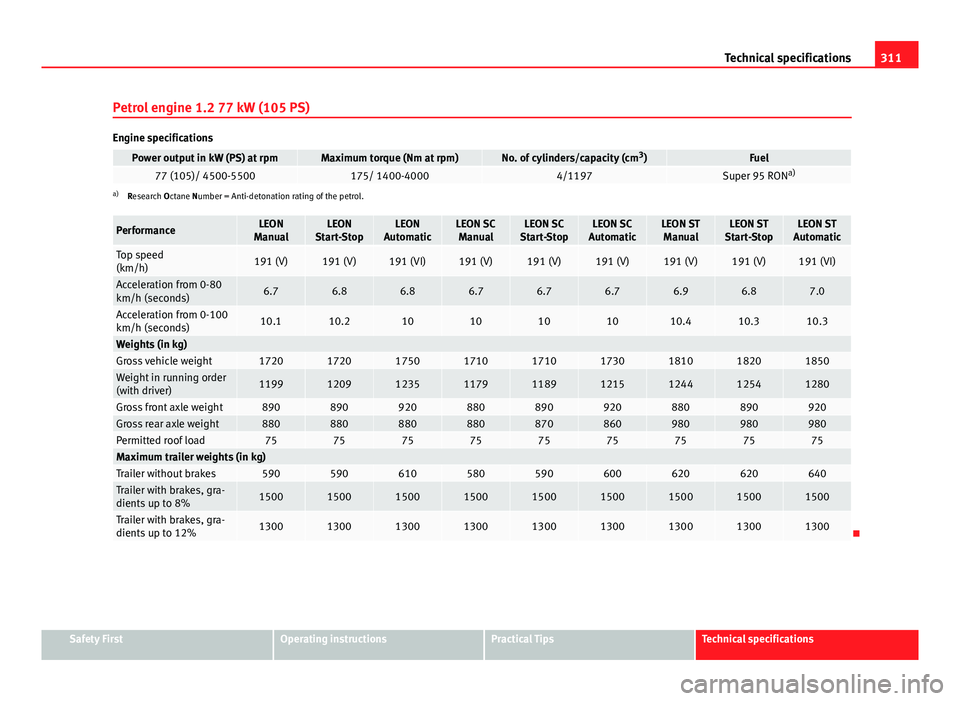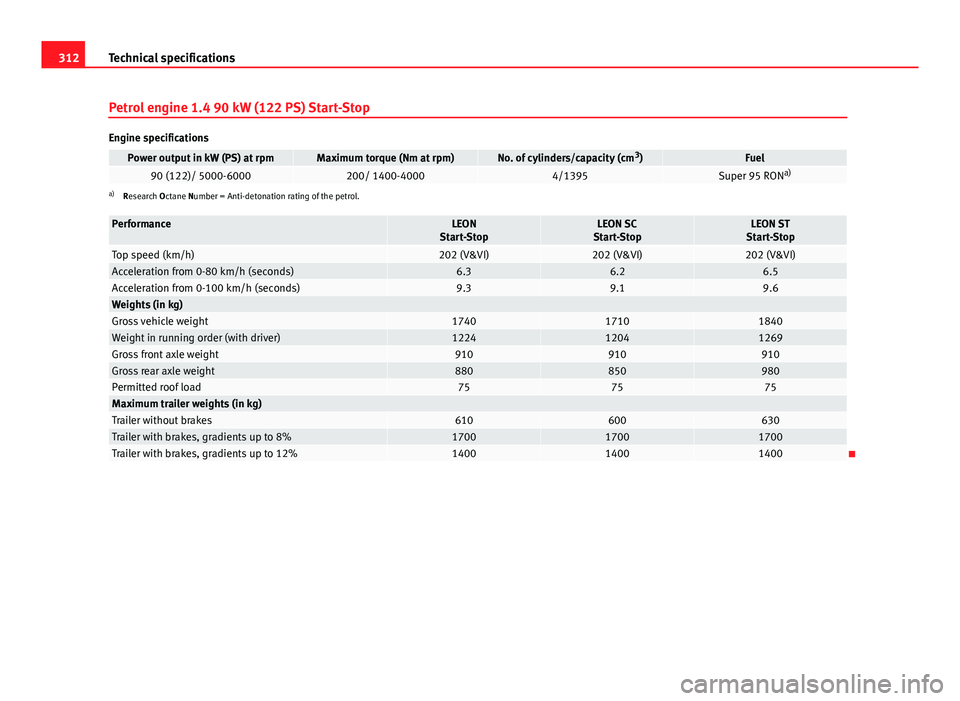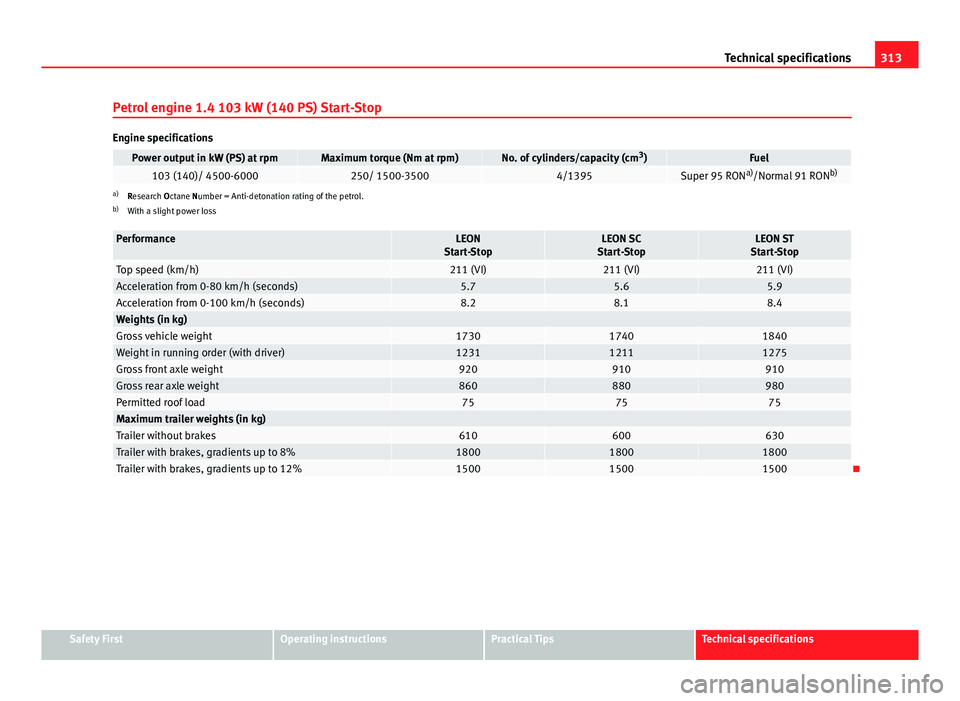2013 Seat Leon Sportstourer fuel cap
[x] Cancel search: fuel capPage 267 of 339

265
Wheels and tyres
Wheels and tyres
Wheels
General notes
– When driving with new tyres, be especially careful during the
first 500 km (300 miles).
– If you have to drive over a kerb or similar obstacle, drive very
slowly and as near as possible at a right angle to the obstacle.
– Check from time to time if the tyres are damaged (punctures,
cuts, cracks or dents). Remove any foreign objects embedded in
the treads.
– Damaged wheels and tyres must be replaced immediately.
– Keep grease, oil and fuel off the tyres.
– Replace any missing valve caps as soon as possible.
– Mark the wheels before taking them off so that they rotate in
the same direction when put back.
– When removed, the wheels or tyres should be stored in a cool,
dry and preferably dark place.
New tyres
New tyres do not give maximum grip straight away and should therefore be
“run in” by driving carefully and at moderate speeds for about the first 500
km (300 miles). This will also increase the useful life of the tyres. The tread depth of new tyres may
vary, according to the type and make of
tyre and the tread pattern.
Concealed damage
Damage to tyres and rims is often not readily visible. If you notice unusual
vibration or the car pulling to one side, this may indicate that one of the
tyres is damaged. Reduce speed immediately if there is any reason to sus-
pect that damage may have occurred. Inspect the tyres for damage. If no ex-
ternal damage is visible, drive slowly and carefully to the nearest special-
ised workshop and have the car inspected.
Tyres with directional tread pattern
An arrow on the tyre sidewall indicates the direction of rotation on single
drive tyres. Always note the direction of rotation indicated when mounting
the wheel. This guarantees optimum grip and helps to avoid aquaplaning,
excessive noise and wear.
Retrofitting Accessories
If you wish to change or fit wheels, rims or wheel trims, we recommend that
you consult with a SEAT Official Service centre for advice regarding current
techniques.
Useful life of tyres
Correct inflation pressures and sensible driving habits will
increase the useful life of your tyres.
– Check tyre pressure at least once a month, and also prior to any
long trip.
Safety FirstOperating instructionsPractical TipsTechnical specifications
Page 272 of 339

270Wheels and tyres
–Also note that winter tyres are no longer effective when the
tread is worn down.
– After fitting the wheels you must always check the tyre pres-
sures. The correct tyre pressures are listed on the sticker on the
inside of the fuel tank flap ⇒ page 265.
In winter road conditions winter tyres will considerably improve vehicle han-
dling. The design of summer tyres (width, rubber compound, tread pattern)
gives less grip on ice and snow. This applies particularly to vehicles equip-
ped with wide section tyres or high speed tyres (code letters H, V or Y on
the sidewall).
Only use winter tyres of the correct type approved for your vehicle. The sizes
of the winter tyres approved for your vehicle are listed in the vehicle docu-
mentation (e.g. EC Certificate of Conformity or COC document 1)
). The vehicle
documentation varies depending on the country of residence. See also
⇒ page 268.
Winter tyres lose a great deal of their properties when the tread is worn
down to a depth of 4 mm.
The performance of winter tyres is also severely impaired by ageing, even if
the tread is still much deeper than 4 mm.
Winter tyres are subject to the following maximum speed limits according to
speed rating code letter: ⇒
Speed rating code letter
⇒ page 268Maximum speed limit
Q160 km/h (140 mph)S180 km/h (140 mph)T190 km/h (140 mph)
Speed rating code letter
⇒ page 268Maximum speed limit
H210 km/h (140 mph)
V240 km/h (150 mph)
(note restrictions)
Vehicles capable of exceeding these speeds must have an appropriate
sticker attached so that it is visible to the driver. Suitable stickers are availa-
ble from the SEAT Official Service and specialised workshop. Please note
regulations to this effect in your country.
“All-weather” tyres can also be used instead of winter tyres.
Using winter tyres with V-rating
Please note that the generally applicable 240 km/h (150 mph) speed rating
for winter tyres with the letter V is subject to technical restrictions; the max-
imum permissible speed for your vehicle may be significantly lower . The
maximum speed limit for tyres with a V-rating depends directly on the maxi-
mum axle weights for your car and on the listed weight rating of the tyres
being used.
It is best to contact a SEAT Official Service to check the maximum speed
which is permissible for the V-rated tyres fitted on your car on the basis of
this information.
WARNING
Exceeding the maximum speed permitted for the winter tyres fitted on
your car can cause tyre failure, resulting in a loss of control of the vehicle
– risk of accident.
1)
COC = certificate of conformity
Page 287 of 339

285
Emergencies
6. Position the leads in such a way that they cannot come into contact with any moving parts in the engine compartment.
Starting
7. Start the engine of the vehicle with the boosting battery and let it run at idling speed.
8. Start the engine of the vehicle with the flat battery and wait two or three minutes until the engine is “running”.
Removing the jump leads
9. Before you remove the jump leads, switch off the dipped beam headlights (if they are switched on).
10.Turn on the heater blower and heated rear window in the vehi- cle with the flat battery. This helps minimise voltage peaks
which are generated when the leads are disconnected.
11.When the engine is running, disconnect the leads in reverse or- der to the details given above.
Connect the battery clamps so they have good metal-to-metal contact with
the battery terminals.
If the engine fails to start, switch off the starter after about 10 seconds and
try again after about half a minute.
WARNING
● Please note the safety warnings referring to working in the engine
compartment ⇒ page 251.
● The battery providing assistance must have the same voltage as the
flat battery (12V) and approximately the same capacity (see imprint on
battery). Failure to comply could result in an explosion.
● Never use jump leads when one of the batteries is frozen. Danger of
explosion! Even after the battery has thawed, battery acid could leak and
cause chemical burns. If a battery freezes, it should be replaced.
● Keep sparks, flames and lighted cigarettes away from batteries, dan-
ger of explosion. Failure to comply could result in an explosion.
● Observe the instructions provided by the manufacturer of the jump
leads.
● Do not connect the negative cable from the other vehicle directly to
the negative terminal of the flat battery. The gas emitted from the battery
could be ignited by sparks. Danger of explosion.
● Do not attach the negative cable from the other vehicle to parts of the
fuel system or to the brake line.
● The non-insulated parts of the battery clamps must not be allowed to
touch. The jump lead attached to the positive battery terminal must not
touch metal parts of the vehicle, this can cause a short circuit.
● Position the leads in such a way that they cannot come into contact
with any moving parts in the engine compartment.
● Do not lean on the batteries. This could result in chemical burns.
Note
The vehicles must not touch each other, otherwise electricity could flow as
soon as the positive terminals are connected.
Safety FirstOperating instructionsPractical TipsTechnical specifications
Page 308 of 339

306Technical specifications
Identifying letters
The identifying letters of the engine can be viewed on the instrument panel.
Important: The engine must be off and the ignition on.
● Hold down the 0.0/SET
4 ⇒ Fig. 38 button for more than 15 seconds.
Information on fuel consumption
Fuel consumption
The consumption and emission details shown on the vehicle
data sticker differ from one vehicle to another. The vehicle fuel consumption and CO 2 emissions can be consulted on the
vehicle data sticker in the spare wheel well, inside the luggage compart-
ment and on the rear cover of the Maintenance Programme.
The fuel consumption and CO 2 emission values refer to the weight category
assigned to your vehicle according to the engine and gearbox combination,
as well as the specific equipment fitted, and is only used to compare be-
tween the different models.
The fuel consumption and CO 2 emissions do not depend only on the per-
formance of the vehicle, they can also differ from the established values de-
pending on other factors such as driving style, road conditions, traffic con-
ditions, environmental conditions, load and number of passengers.
Calculation of fuel consumption
The consumption values have been calculated based on measurements per-
formed or supervised by certified CE laboratories according to the latest ver-
sion of directives 715/2007/EC and 80/1268/CEE (for more information
consult the European Union Publications Office at EUR-Lex: © European Un- ion, http://eur-lex.europa.eu/en/index.htm) and are valid for the kerb
weight indicated for the vehicle.
Note
In practice, and considering all the factors mentioned here, consumption
values can differ from those calculated in the current European regulations.
Weights
Kerb weight refers to the basic model with a fuel tank filled to 90% capacity
and without optional extras. The figure quoted includes 75 kg to allow for
the weight of the driver.
For special versions and optional equipment fittings or for the addition of
accessories, the weight of the vehicle will increase ⇒
.
WARNING
● Please note that the centre of gravity may shift when transporting
heavy objects; this may affect vehicle handling and lead to an accident.
Always adjust your speed and driving style to suit road conditions and re-
quirements.
● Never exceed the gross axle weight rating or the gross vehicle weight
rating. If the allowed axle load or the allowed total weight is exceeded,
the driving characteristics of the vehicle may change, leading to acci-
dents, injuries and damage to the vehicle.
Page 312 of 339

310Technical specifications
Petrol engine 1.2 63 kW (85 PS)
Engine specifications
Power output in kW (PS) at rpmMaximum torque (Nm at rpm)No. of cylinders/capacity (cm 3
)Fuel63 (85)/ 4300-5300160/ 1400-35004/1197Super 95 RON a)a)
Research Octane Number = Anti-detonation rating of the petrol.
PerformanceLEONLEON SCLEON STTop speed (km/h)178 (V)178 (V)178 (V)Acceleration from 0-80 km/h (seconds)7.67.57.8Acceleration from 0-100 km/h (seconds)11.911.812.1Weights (in kg)Gross vehicle weight169017001800Weight in running order (with driver)118811681233Gross front axle weight880880890Gross rear axle weight860870960Permitted roof load757575Maximum trailer weights (in kg)Trailer without brakes590580610Trailer with brakes, gradients up to 8%130013001300Trailer with brakes, gradients up to 12%110011001100
Page 313 of 339

311
Technical specifications
Petrol engine 1.2 77 kW (105 PS)
Engine specifications
Power output in kW (PS) at rpmMaximum torque (Nm at rpm)No. of cylinders/capacity (cm 3
)Fuel77 (105)/ 4500-5500175/ 1400-40004/1197Super 95 RON a)a)
Research Octane Number = Anti-detonation rating of the petrol.
PerformanceLEON
ManualLEON
Start-StopLEON
AutomaticLEON SC ManualLEON SC
Start-StopLEON SC
AutomaticLEON ST ManualLEON ST
Start-StopLEON ST
Automatic
Top speed
(km/h)191 (V)191 (V)191 (VI)191 (V)191 (V)191 (V)191 (V)191 (V)191 (VI)
Acceleration from 0-80
km/h (seconds)6.76.86.86.76.76.76.96.87.0
Acceleration from 0-100
km/h (seconds)10.110.21010101010.410.310.3
Weights (in kg)Gross vehicle weight172017201750171017101730181018201850Weight in running order
(with driver)119912091235117911891215124412541280
Gross front axle weight890890920880890920880890920Gross rear axle weight880880880880870860980980980Permitted roof load757575757575757575Maximum trailer weights (in kg)Trailer without brakes590590610580590600620620640Trailer with brakes, gra-
dients up to 8%150015001500150015001500150015001500
Trailer with brakes, gra-
dients up to 12%130013001300130013001300130013001300
Safety FirstOperating instructionsPractical TipsTechnical specifications
Page 314 of 339

312Technical specifications
Petrol engine 1.4 90 kW (122 PS) Start-Stop
Engine specifications
Power output in kW (PS) at rpmMaximum torque (Nm at rpm)No. of cylinders/capacity (cm 3
)Fuel90 (122)/ 5000-6000200/ 1400-40004/1395Super 95 RON a)a)
Research Octane Number = Anti-detonation rating of the petrol.
PerformanceLEON
Start-StopLEON SC
Start-StopLEON ST
Start-Stop
Top speed (km/h)202 (V&VI)202 (V&VI)202 (V&VI)Acceleration from 0-80 km/h (seconds)6.36.26.5Acceleration from 0-100 km/h (seconds)9.39.19.6Weights (in kg)Gross vehicle weight174017101840Weight in running order (with driver)122412041269Gross front axle weight910910910Gross rear axle weight880850980Permitted roof load757575Maximum trailer weights (in kg)Trailer without brakes610600630Trailer with brakes, gradients up to 8%170017001700Trailer with brakes, gradients up to 12%140014001400
Page 315 of 339

313
Technical specifications
Petrol engine 1.4 103 kW (140 PS) Start-Stop
Engine specifications
Power output in kW (PS) at rpmMaximum torque (Nm at rpm)No. of cylinders/capacity (cm 3
)Fuel103 (140)/ 4500-6000250/ 1500-35004/1395Super 95 RON a)
/Normal 91 RON b)a)
Research Octane Number = Anti-detonation rating of the petrol.
b) With a slight power loss
PerformanceLEON
Start-StopLEON SC
Start-StopLEON ST
Start-Stop
Top speed (km/h)211 (VI)211 (VI)211 (VI)Acceleration from 0-80 km/h (seconds)5.75.65.9Acceleration from 0-100 km/h (seconds)8.28.18.4Weights (in kg)Gross vehicle weight173017401840Weight in running order (with driver)123112111275Gross front axle weight920910910Gross rear axle weight860880980Permitted roof load757575Maximum trailer weights (in kg)Trailer without brakes610600630Trailer with brakes, gradients up to 8%180018001800Trailer with brakes, gradients up to 12%150015001500
Safety FirstOperating instructionsPractical TipsTechnical specifications